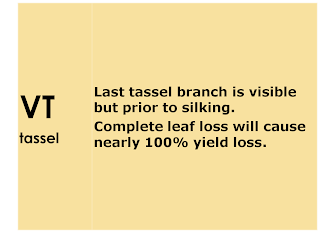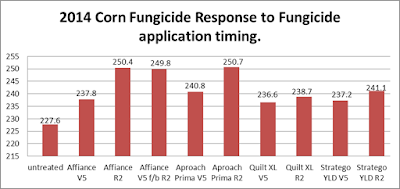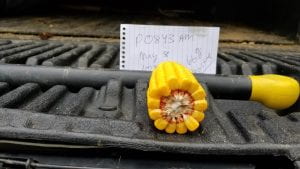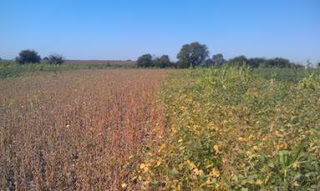Del Voight and Greg Roth – Penn State Extension
 Introduction: During the last few years, there has been an increasing interest in growing sunflowers in Pennsylvania. There are significant markets for sunflower seed and sunflower products, like oil, in the state but traditionally these have been imported from other states or overseas. Recent disruptions in world grain trade and higher transportation costs have caused higher prices for sunflower products like birdseed and sunflower cooking oil. This has created some interest in increasing local production and or processing in the state. Sunflowers are also increasingly used as part of an agritainment enterprise on some farms where sunflower festivals, photo opportunities, and cut flower sales can generate significant income. Sunflowers can provide a nice link between the farm community and the general public.
Introduction: During the last few years, there has been an increasing interest in growing sunflowers in Pennsylvania. There are significant markets for sunflower seed and sunflower products, like oil, in the state but traditionally these have been imported from other states or overseas. Recent disruptions in world grain trade and higher transportation costs have caused higher prices for sunflower products like birdseed and sunflower cooking oil. This has created some interest in increasing local production and or processing in the state. Sunflowers are also increasingly used as part of an agritainment enterprise on some farms where sunflower festivals, photo opportunities, and cut flower sales can generate significant income. Sunflowers can provide a nice link between the farm community and the general public.
Sunflowers have also been used as part of cover crop mixes in the state. Sunflowers have a deep taproot system and can help alleviate compacted soils. Sunflowers also serve to provide some diversity to cover crop mixes and provide pollinator services to honeybees and Monarch butterflies. Sunflowers also provide feed for wildlife and birds.
Because of the growing interest in sunflowers, we have reviewed production practices being used by producers in the state and other states to develop some sunflower production recommendations for Pennsylvania.
Crop Rotations: Sunflowers can be grown as both a full season crop and as a double crop following barley or wheat. In general, the most profitable opportunity appears to be as a double crop. In this scenario, sunflowers would compete with double crop soybeans. Sunflowers are a bit more drought tolerant, more frost tolerant, and have a lower seed cost. In some environments these advantages can lead to a potentially more profitable double crop than soybeans. Because of their frost tolerance, sunflowers can likely be planted later than double crop soybeans.
Varieties: Sunflowers are generally produced as either black oil seed or striped seed varieties. Generally, the black oil seed varieties are used for oil and birdseed. The striped varieties are also used for birdseed but are mostly used as snackfood. Within the oilseed types there is variation in the oil content and composition. Generally high oleic type sunflowers are of best use for oil and should be the variety to be used for oil. However if bird seed is the end market then low linoleic or high oleic may be planted for this market. As with many crops, there are maturity ranges for sunflowers from 70 to 100-day or more maturities. For double crop production after small grains varieties in the 70-80 day maturity range seem to be most adapted. For the agritainment sector there are alot of interesting sunflower varieties available now in garden seed catalogs that can add diversity to a sunflower planting. These can have different colors, with various shades of yellow or even orange, red or white flowered varieties. For our test plots we planted 2 varieties one is a 100 day clearfield variety that has resistance to ther herbicide Beyond which helps to manage weeds. The other variety is a 70 day and it is resistant to ALS chemistry. We are conducting a study to compare populations from 25,000 to 45,000 ppa.
There were 841 acres of sunflowers grown for grain reported in the 2017 Pennsylvania Census of Agriculture. That acreage reported a yield of over 971000 lbs of sunflowers. We feel that sunflower acreage has likely doubled since then due to increased farmer interest and profitability.
Planting Date: Sunflowers are similar to soybeans in that they can be planted from late April until mid to late July in some areas. For May plantings, sunflowers would compete with high yielding full season crops of corn or soybeans and that may be a challenge economically. Sunflowers are better able to compete with soybeans under double crop conditions, especially under lower yielding double crop soybean conditions.
Variety selection: There are different types of sunflowers and the oil yield can vary. Generally high oleic type sunflowers are of best use for oil and should be the variety to be used for oil. However if bird seed is the end market then low linoleic or high oleic may be planted for this market. Always check with your market to see if they have special requirements for varieties. As with many crops there are maturity ranges for sunflowers from 70 to 100-day or more maturities. For double cropping varieties in the 70-80 day maturity ranges would be of best utility to have a timely fall harvest.
Row Width and Plant Populations: Like soybeans, sunflowers can be planted in 30 or 15 inch rows or with a grain drill. For best yields, getting good emergence and uniform stands is critical. Most reports from growers in Pa have settled on 30 inch row placement with 1 inch deep settings. There are also reports that planting north to south is best with the heads facing either east or west into the rows so birds cannot perch on adjacent heads to feed. This can also assist in the flow of heads into the combine head. Plant populations can vary depending on planting date. Generally a final stand between 25 to 30,000 ppa should be the goal. Plant populations should be adjusted to accommodate varying soil and seed conditions. On droughty soils populations of 20-24000 plants per acre may be justified.
Fertility: Fertilizer requirements for sunflowers are modest. Penn State recommendations call for 70 pounds of N per acre for a 2000 lb yield goal and a crop removal of 40 pounds of P2O5 and 30 pounds of K2O. On many of our soils with a history of manure, phosphorus and potassium can be eliminated and N recommendations can be reduced. Locally growers are achieving 2200lb double crop yields with 40 lb of applied N. Excessive N applications could result in more lodging and should be avoided.
Weed Control: There are numerous products labeled for control of weeds in sunflowers commonly available at local dealers. Double crop sunflowers have few weeds to manage. A few examples of potential sunflower herbicides include but are not limited to residual products containing metolachlor(Dual), sulfentrazone( Authority)and Pendimethalin(Prowl)as well as post products containing quizafop ( Assure), sethoxydim (Poast)or clethodim(Select). The key is to control broadleaves with residuals as in crop solutions for broadleaves are limited for this crop.
Insects and Disease: There have been few insect problems reported in Pennsylvania production fields so generally there is not a need to spray insecticides. There are also some diseases that may impact the crop. Seedling disease could be an issue in some environments since sunflowers lack the vigor of soybeans. Benefits to seed treatments with fungicides have been reported in some areas to improve stands and rooting at seedling stages. Potential other sunflower diseases that might be a problem in our area include Sclerotinia (white mold), and leaf diseases like Alternaria Leaf Blight, Septoria Leaf Blight , and Leaf Rust. These might be a particular problem under the high humidity in late season double crop production in Pennsylvania. Growers have done some trials with an early heading application of a fungicide with positive results. However more research in this area is required and response can vary from farm to farm.
Wildlife Birds, deer and groundhogs can all be pests of sunflowers. For deer and groundhogs, management tactics would be similar to those used for soybeans. For birds, as mentioned previously, planting in north south rows helps to avoid feeding damage. It may be necessary to avoid planting near wetlands or other areas with high densities of birds. Larger fields also help to limit damage compared to small isolated fields. Applications of fungicides at heading may be warranted if diseases are present on leaves below the seed head. Scouting is important. In our plots near Lebanon Pa last season we saw a 400lb per acre increase on fields with visible disease and no response where diseases did not exist.
Harvesting: Sunflowers are generally ready for combine harvest when the back of the flowers turn brown. Sunflowers may be harvested with numerous types of combine heads. However the harvest loss may be extreme with many heads. Local farmers have modified heads to reduce harvest loss. One example is this row crop head modified with a simple pan that funnels shattered seed back on the platform. Be sure to carefully investigate combine headers before harvesting on a large scale.
Yield Performance: There is not a lot of yield performance data available in Pennsylvania and most of that is available is double crop. Farmers report yields of 1500 to 2200 pounds per acre following wheat in South Central PA. The good double crop yield potential here could be due to late August and September rainfall we often get in our region. These yields compares favorably with results from states with similar growing seasons like Kansas or Missouri. The potential yield of full season sunflowers has not been documented well, but we would estimate it in the 2500 to 3000 pound range under good conditions. In many areas, such as the Dakotas, full season yields are comparable to our double crop yield potential.
When harvesting sunflowers, be aware that they can produce a lot of dust. Sunflowers can require one or two cleanings to get the chaff out of the grain. Sunflowers also have a test weight of 30 pounds, so this requires more trucking for a given weight of sunflowers.
Sunflower prices fluctuate as other commodity prices do. Prices in sunflower producing areas in the Dakotas have ranged from 10 to nearly 30 cents/pound over the last 20 years. There is an additional cost to transport sunflowers to our markets for processing. Assuming a local price of 30 cents/pound, a 2000 pound per acre sunflower crop would generate more revenue than a 35 bushel per acre soybean crop at 13.50 with less drought and frost risk.
Potential of Sunflowers as a Crop in Pennsylvania Sunflowers have some potential to increase in acreage in our state. We have a large demand for sunflowers as birdseed, our snack food industry uses a substantial amount of sunflower oil, we have markets for the sunflower meal as a livestock feed and we have shown there is a good potential for the agritainment aspect of our sunflower fields as well. In addition, our producers have shown that good yields of sunflowers are possible under double crop conditions and they seem to be potentially profitable under current prices. Sunflowers would also add some diversity to our grain crop rotations and provide benefits to pollinators and wildlife as well.
Field Ready – What a field looks like ready to harvest


Video: Combine harvesting sunflowers Werner Acres LLC.
Combining Sunflowers
Certifying yield and a look at the combine head ideal for sunflowers
Picture of a combine head for use in sunflowers.

Picture of uncleaned sunflowers directly from combine.







 ost areas received little moisture after planting and soil variability and lack of rain has resulted in high variations in germination and subsequent corn height and growth stage within the rows of corn. When drenching rains returned the corn crop responded and the variation is more prominent. This is most evident in the non uniform tassel emergence that we are experiencing in early July. For this article we will use the tassel/silk emergence timing to predict when black layer/ physiological maturity(PM) will take place. PM is the time the kernal is filled and all flow or fill of the kernal is complete kernal moisture is about 32% moisture well past silage harvest parameters. The plant is beginning to dry down rapidly at PM most of the green tissue is now brown and the ears are drying down rapidly for dry grain harvest and or high moisture corn.
ost areas received little moisture after planting and soil variability and lack of rain has resulted in high variations in germination and subsequent corn height and growth stage within the rows of corn. When drenching rains returned the corn crop responded and the variation is more prominent. This is most evident in the non uniform tassel emergence that we are experiencing in early July. For this article we will use the tassel/silk emergence timing to predict when black layer/ physiological maturity(PM) will take place. PM is the time the kernal is filled and all flow or fill of the kernal is complete kernal moisture is about 32% moisture well past silage harvest parameters. The plant is beginning to dry down rapidly at PM most of the green tissue is now brown and the ears are drying down rapidly for dry grain harvest and or high moisture corn. is would place silage harvest from between August 15 to August 20, 2023. The practical implication is that if a field is typically harvested around labor day for silage and that is applied this year just going by a calendar date the result might be a dryer or wetter harvest for the structure it is intended to be placed into for ensiling. There is no substitute for checking the crop ear for relative maturity as it develops to better time the harvest to maximize forage quality and ensure proper ensiling for the silage whichever structure it is to be placed for winter feed out.
is would place silage harvest from between August 15 to August 20, 2023. The practical implication is that if a field is typically harvested around labor day for silage and that is applied this year just going by a calendar date the result might be a dryer or wetter harvest for the structure it is intended to be placed into for ensiling. There is no substitute for checking the crop ear for relative maturity as it develops to better time the harvest to maximize forage quality and ensure proper ensiling for the silage whichever structure it is to be placed for winter feed out. If we understand this relationship with GDD and crop growth we can then look to technology to better time harvests. Computer and Phone applications such as Bushels, Climate view, and man
If we understand this relationship with GDD and crop growth we can then look to technology to better time harvests. Computer and Phone applications such as Bushels, Climate view, and man y others will allow growers to map a field or fields and then check daily for comparisons of this years GDD compared to either 10 or 15 year averages and better adjust estimated harvest timing. Penn State employs these technologies to predict harvests as well as pest activity.
y others will allow growers to map a field or fields and then check daily for comparisons of this years GDD compared to either 10 or 15 year averages and better adjust estimated harvest timing. Penn State employs these technologies to predict harvests as well as pest activity.
 soybeans on the left (planted two weeks earlier than the beans on the right) could be harvested two weeks before later plantings. If I were to wait as little as two weeks to harvest the plots until the rest of the planting dates matured I would lose a significant amount of soybeans from shatter losses.
soybeans on the left (planted two weeks earlier than the beans on the right) could be harvested two weeks before later plantings. If I were to wait as little as two weeks to harvest the plots until the rest of the planting dates matured I would lose a significant amount of soybeans from shatter losses. Combines can be operated to reduce losses without affecting the harvesting rate. This guide describes the major sources of loss. Consider shatter losses of 2 percent acceptable. Average losses are 5 percent or more.
Combines can be operated to reduce losses without affecting the harvesting rate. This guide describes the major sources of loss. Consider shatter losses of 2 percent acceptable. Average losses are 5 percent or more.








